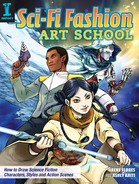Clothes
There is no excess here in the wasteland. Every scrap is treasured and used, and clothes are worn until they fall apart. Learning how to draw fabric that’s torn and frayed will help set the scene.

COMING APART AT THE SEAMS
Garments are joined together with seams. As clothes start to wear out, the seams are usually the first areas to go.
Use a curve placed against the seam to show where the fabric will start separating. Then add frayed edges to the torn thread and uneven fabric to the bottom part of the curve. At the corners, where the rip is still attached to the seam, the thread will be visibly stretched out and attempting to hold the two pieces of fabric together.

THAT RIPPED LOOK
If you’re drawing tears that will be seen from a distance, simplify them by creating some uneven lines to represent jagged fabric.

WEAR AND TEAR
Fabric takes a beating on parts of the garment that get a lot of pull and friction from the body, like the knees or elbows.

PROGRESSION OF DAMAGE
Practice taking a pair of jeans from brand-new to tattered and dirty. First, identify the areas that will take the brunt of the damage. The most severe tearing will happen at the back edge, tapering off to the front, because the lower part gets dragged through mud, sand and gravel. When you’ve noted the correct placement, add tears and frayed seams.

HIGH DAMAGE VS. LOW DAMAGE
Some areas of a garment will take more wear than others. Use smoother lines on the sections of fabric that aren’t edges, like the curve of the hood and the wrap of the skirt. Then sketch the bottom of the fabric with uneven, broken lines to contrast it with the areas that are just folded.

EXTREME TEARING
You don’t have to stop at minor damage to your characters’ clothing. Here, one of the sleeves has completely torn off, and she’s wearing the collar of another shirt as a necklace.

FABRIC WRAPS
Wrapping torn strips of fabric around a body shouldn’t be neat and even. This cloth represents the far end of the damage scale—fabric that’s so worn it was useless on its own and has been broken down for a new purpose. As such, the strips themselves are uneven, and the wearer probably cares more about coverage than neatness.

FULL COVERAGE
Try drawing someone with wrapped arms or legs. Make sure to keep it messy, and bear in mind that the wraps will bulge a bit on the sides as the fabric strips overlap each other.
